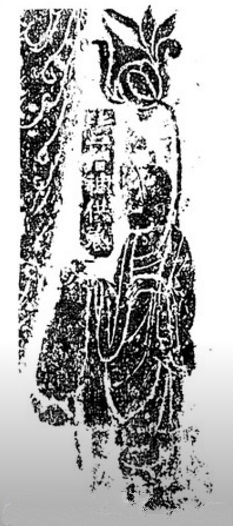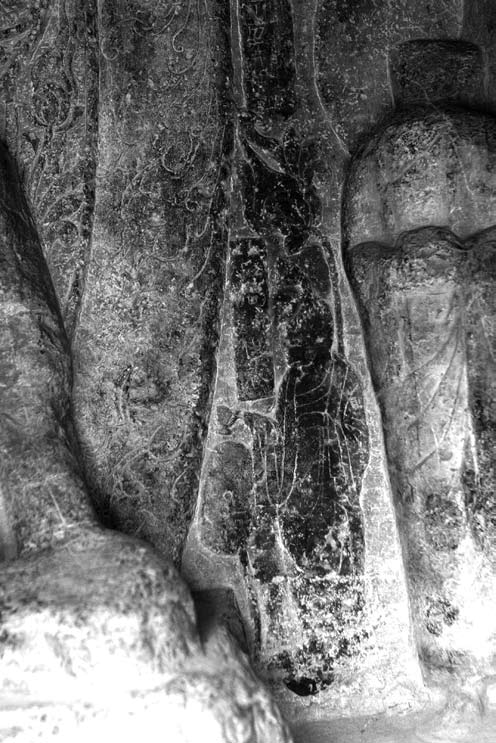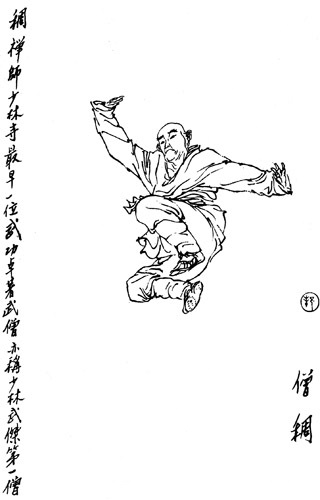ZEN MESTEREK ZEN MASTERS
« Zen főoldal
« vissza a Terebess Online nyitólapjára

僧稠 Sengchou (480-560)

Relief with Inscription, North Wall, Xiaonanhai Central Grotto
The inscription reads: “Monk Sengchou makes offerings.”
The Xiaonanhai Grottos, built in the Northern Qi dynasty (550-577), are located on the outskirts of Anyang in Henan Province and comprise East, Central, and West Grottos. Of special importance is the Central Grotto, which has a carved inscription (known as the Fangfashi loushibanjing ji 方法 师镂石板经记) over its entrance relating a general overview of the construction process. This grotto, while small in size, is rich in both visual imagery and text, providing valuable information on Northern Qi Buddhism and cave-temples. Construction on the Central Grotto began in the year Tienbao 1 (550).
Five years later, in Tienbao 6 (555), the statues and relief carvings inside the cave were completed, due in large part to the influence of Seng Chou 僧稠 (480-560), a monk whose legendary meditation accomplishments had a profound influence on Chinese Buddhist history as a whole. The inscription on the gate is thought to have been carved soon after Seng Chou's death. its most essential elements are based on the Nirvana Sutra (Skt., Nirvana-sutra) “ 《大般涅槃經》聖行品 ”, a scripture that was formative to the ideology and enterprises of Seng Chou. The author also explains that Buddhists of the day were particularly interested in finding ways to guarantee their salvation and details some of the means by which they attempted to do so.
With such a context, as described in the Sutra of Visualization of the Buddha of Infinite Life 佛 说观无量寿佛经 ( Amitayurdhyana-sutra), we observe on the grotto's west wall imagery of Amitabha's Pure Land. Whilst, on the east wall we can see a imagery where Maitreya, the Buddha of Future preachs in the forth level of Six Heavens of Desire. This forth heaven is also called Heaven of Joy. These two pieces of carved imageries witness the Pure Land Buddhism as a major Buddhist school in northern China in the 5th centrury.
https://www.flickr.com/photos/24164990@N07/sets/72157620852391926/
Christoph Anderl
Analysis of the texts attributed to Sengchou 僧稠 in Pelliot 3559 (German, Vienna 1995)
Chou chanshi yaofang 稠禪師藥方, traditonally attributed to Sengchou 僧稠, German translation (Vienna 1995)

Rou Quan – A shaolin Lágy Ököl 《少林柔拳》
http://www.rgm.hu/index.php?mid=114
[...]
A kutatások nem támasztják alá egyértelműen, hogy valóban Hui Ke Apát hozta létre a Rou Quan-t. Hui Ke életéről a legkorábbi feljegyzés Hui Jiao ( 慧皎 ) a Jiaxiang templom Kuaiji Hegy (Sichuan tartomány) 519-es munkája a Kiemelkedő Szerzetesek Emlékiratai (高僧傳, Gao Seng Zhuan) http://tripitaka.cbeta.org/T50n2059, valamint annak folytatása, a 645-ben íródott Sui Gao Seng Zhuan ( 隋高僧傳 ). Köztudott, hogy Hui Ke levágta egyik karját, hogy így bizonyítsa Bodhidharmának eltökéltségét a Chan iránt, kérve, hogy tanítsa őt. A Rou Quan viszont nem "egykezes" stílus (bár személyesen részt vehetett a mozdulatok / technikák kialakításában). Több utalás olvasható Sheng Chou szerzetesről, akinek a Rou Quan két rövid formáját tulajdonítják (napjainkban: 一路 , 二路 ). Hui Ke a NeiGong gyakorlatai mentén, és Sheng Chou két formája alapján hozta létre a Rou Quan hosszú, 108-as gyakorlatát ( 三路 ), a Liang Dinasztia 550-70-es éveiben. Gyakorlása során a Qi ( 气 ) a Dan Tian -ben ( 丹田 ) gyűlik, keringetése a Bai Hui -tól ( 百会 ) a Hui Yin -ig ( 会阴 ) biztosított. Egészségmegőrző-, és belső mentáűlis erősítő hatása hamar érezhető. Érdekesség, hogy a "Rou Quan" mint megnevezés feltűnik több iratban is a Yang Taiji keletkezésével összefüggésben: az emberek a születendő stílust "Rou Shou"-nak ( 柔手 ) azaz "Puha v. Rugalmas Kéz"-nek neveztek. A Rou Quan (és Rou Gong módszerek) a leghosszabb átadási vonalat jelentik a kolostorban, azaz a legrégebbi templomi vonala a harcművészetnek.
[...]